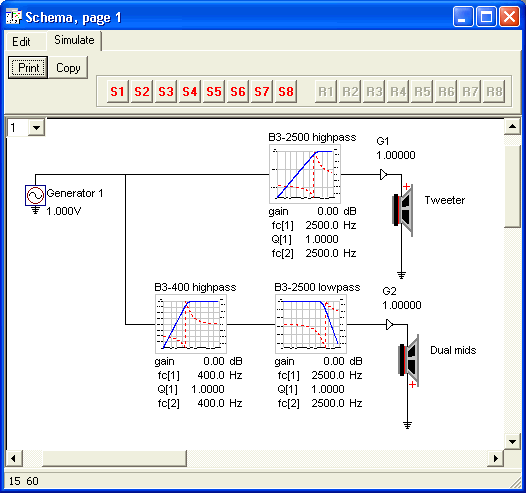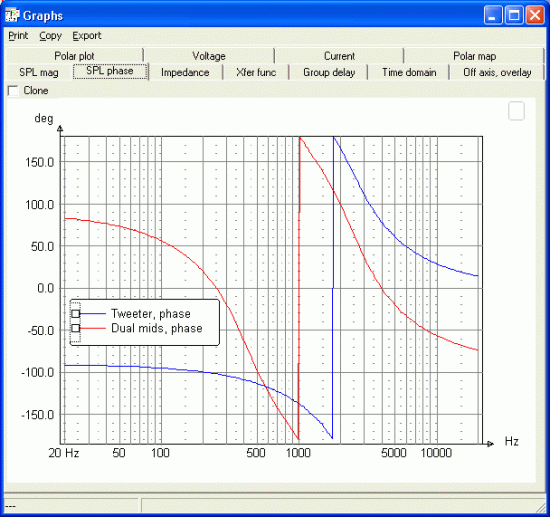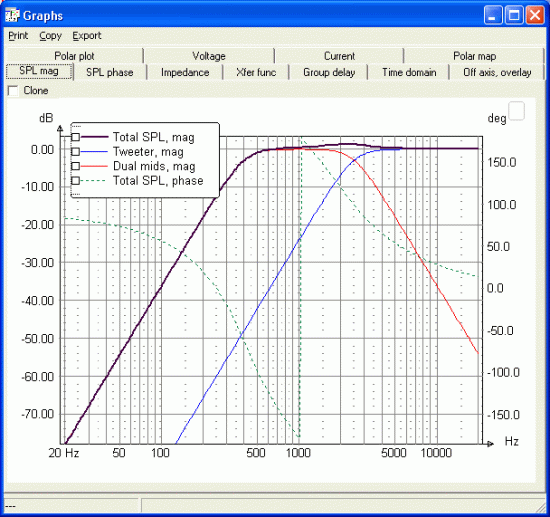The big concept of the Duelund XO can be summarized as "all drivers in phase at all frequencies." To do that, he stacks LR2 filters when using 3 or more drivers. For example:
Woofer: LR2-400 lowpass, LR2-2500 lowpass
Midrange: LR2-400 highpass, LR2-2500 lowpass
Tweeter: LR2-400 highpass, LR2-2500 highpass
It seems reasonable that you could apply the same big concept to other filter types so I gave it a try with B3 filters. I modeled the MTM section of a WMTMW using B3 filters and "perfect" drivers. I only have the demo version of LspCAD so I couldn't do the whole WMTMW but this will show it well enough.
Here's the standard non-Duelund-style schematic.

B3 filters should track in phase quadrature, i.e. 90 degrees apart. Notice how the phase tracking falls apart at lower frequenies.

Because of the poor phase tracking, there is a broad 2dB hump around the crossover frequency.

Too many pics so the Duelund-style version is in the next post.
Woofer: LR2-400 lowpass, LR2-2500 lowpass
Midrange: LR2-400 highpass, LR2-2500 lowpass
Tweeter: LR2-400 highpass, LR2-2500 highpass
It seems reasonable that you could apply the same big concept to other filter types so I gave it a try with B3 filters. I modeled the MTM section of a WMTMW using B3 filters and "perfect" drivers. I only have the demo version of LspCAD so I couldn't do the whole WMTMW but this will show it well enough.
Here's the standard non-Duelund-style schematic.
B3 filters should track in phase quadrature, i.e. 90 degrees apart. Notice how the phase tracking falls apart at lower frequenies.
Because of the poor phase tracking, there is a broad 2dB hump around the crossover frequency.
Too many pics so the Duelund-style version is in the next post.

 Short version, it's a way to use a single formula to describe both the magnitude and phase behavior of a filter using imaginary numbers: j=sqrt(-1). The stacked LR2 filters match Duelund's formula for any reasonable spacing of the crossover frequencies. I checked it at a=2, with the two frequencies at approximately 950 and 1050, and it still works. As a goes below 2, it starts to not match, but you'd never build a real 3-way with the two frequencies so close.
Short version, it's a way to use a single formula to describe both the magnitude and phase behavior of a filter using imaginary numbers: j=sqrt(-1). The stacked LR2 filters match Duelund's formula for any reasonable spacing of the crossover frequencies. I checked it at a=2, with the two frequencies at approximately 950 and 1050, and it still works. As a goes below 2, it starts to not match, but you'd never build a real 3-way with the two frequencies so close.

 ops: .
ops: . 

Comment